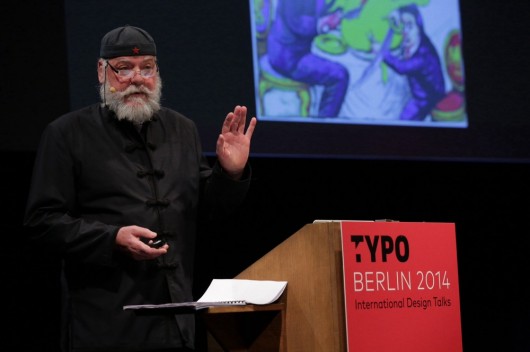
photo © Gerhard Kassner
“It’s not where you get it from, it’s where you take it to.”
True originality in Roger’s opinion, and own words, was “as rare as rocking horse shit”. From his point of view he had only ever discovered two artists to whom which he could bestow upon the title of ‘True Original’. The first was the American ceramics artist of the late 19th century, George E.Ohr (or perhaps as he was better known as “The Mad Potter of Biloxi”). George not only had an amazing, gravity defying moustache but also an incredible skill with throwing pots; which has yet to be fully understood or even replicated today. The second was also an American and incidentally another ‘George’, George Herriman; a cartoonist who created the not so popular but undeniably, hugely influential strip ‘Krazy Kat’, during the early 20th century. I’m sure it was intentional to introduce these two but seemingly dissimilar artists (a potter and an cartoonist) as the backdrop to explore his own work; a fusion of satirical illustration, painting and pottery.

Roger Law used to be famous. He was the evil genius behind the mocking caricature puppets of “Spitting Image”, the award winning satirical TV series shown on UK TV from 1983–1996 and was franchised around the world, from Russia to the USA. When the satire bubble burst, Law did the decent thing and exiled himself to the Southern Hemisphere. He now makes ceramics in Jingdezhen, China's “Porcelain City”. His ceramic work is as beautiful and witty as his caricature puppets were rude and ugly.
Perhaps Roger’s most well known work was that for the TV programme ‘Spitting Image’ which ran from 1984-1996; a satirical puppet show that brought the familiar political cartoons from the newspaper to life in a way we had never seen before. It was the work of 18th century English satirists George Cruikshank and James Gillray that served as his greatest influence on Spitting Image; often appropriating near exact settings and situations seen in their works for his own (updating the figures depicted of course to those of modern politicians). As Roger saw it since their work was forever etched on the British psyche, any image that people were familiar with was fair game; “grist to the satirist’s mill” as he put it. Eventually syndicated globally, Spitting Image brought Roger a fame he felt was too much to bear and when the show finally finished in 1996 he fled grey England for the sunny shores of Australia.
“These guys weren’t working towards a body of work, they were working for a living … It was great to be somewhere, surrounded by people that were making things all the time.”
Over the next few years Roger was reclusive and travelled around Australia painting and illustrating the weird and wonderful fauna the country had to offer; leafy sea dragons, mudskippers and cockatoos, to name a few. It was during this time that he first became aware of the potters and imperial kilns of Jingdezhen in China, or has as he more humorously quipped: “Sooner or later in Australia you hear about China … everything that comes up out of the ground ends up going there”. It was in Jingdezhen that he feel in love with pottery and porcelain (of ever increasing sizes) and he would collaborate heavily with the artist, and life-long friend, Ah Xian.
Ah Xian introduced Roger to a way of life in China that both inspired and fascinated him, as he put it “These guys weren’t working towards a body of work, they were working for a living … It was great to be somewhere, surrounded by people that were making things all the time.” It would here be that he would also learn first hand a lesson in ‘artistic re-appropriation’ (theft basically) as he left some of his pottery moulds there and returned to find his works in mass production sold cheaply on the streets. Admittedly he was a little pissed off about this at first but reflecting on his own career, particularly on his adaptations of Gillray’s and Cruikshank’s works for Spitting Image, he rationalised it as:
“If you rip people off, you must expect eventually to be ripped off in return”.
Reflecting on his skill as an illustrator, his ability to simply draw, as being his single greatest asset in life, he mused that with this alone he was able to create and even take, whatever he needed from wherever he wanted. He concluded with a dazzling array of self portraits in various imaginary situations and left us with the thought: “If you can draw, you can steal anything you want and be anyone you want to be”. To me at least, this conclusion was reassuring and even heartwarming. As artists and designers we shouldn’t be so focussed on being original all the time, as everyone is influenced by the things that have come before them, and instead, we should focus on the act of creating and being and believing in ourselves.
Text — Brent Riddell






















